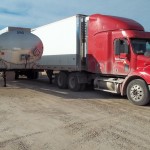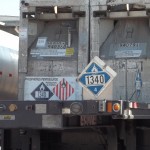Throughout the Hazardous Material Regulations (HMR) of the PHMSA/USDOT it is primarily the responsibility of the Shipper of a hazardous material to provide the information necessary to safely transport the HazMat and to communicate its potential hazards. However, 49 CFR 172.606 contains requirements for the Carrier to provide contact information during certain situations of HazMat transportation. The purpose of this article is to explain in detail the requirements of this regulation, summarized as follows:

- A HazMat Carrier must instruct the operators of the vehicle to contact them in the event of an incident involving the HazMat pursuant to paragraph (a) of §172.606.
- The HazMat Carrier must make information available with the hazardous material whenever it is parked during transportation and is separated from its motive power pursuant to paragraph (b) & (c) of §172.606.
49 CFR 172.606 Carrier information contact reads:
(a) Each carrier who transports or accepts for transportation a hazardous material for which a shipping paper is required shall instruct the operator of a motor vehicle, train, aircraft, or vessel to contact the carrier (e.g., by telephone or mobile radio) in the event of an incident involving the hazardous material.
(b) For transportation by highway, if a transport vehicle, (e.g., a semi-trailer or freight container-on-chassis) contains hazardous material for which a shipping paper is required and the vehicle is separated from its motive power and parked at a location other than a facility operated by the consignor or consignee or a facility (e.g., a carrier’s terminal or a marine terminal) subject to the provisions of §172.602(c)(2), the carrier shall—
(1) Mark the transport vehicle with the telephone number of the motor carrier on the front exterior near the brake hose and electrical connections or on a label, tag, or sign attached to the vehicle at the brake hose or electrical connection; or
(2) Have the shipping paper and emergency response information readily available on the transport vehicle.
(c) The requirements specified in paragraph (b) of this section do not apply to an unattended motor vehicle separated from its motive power when the motor vehicle is marked on an orange panel, a placard, or a plain white square-on-point configuration with the identification number of each hazardous material loaded therein, and the marking or placard is visible on the outside of the motor vehicle.
Before we begin looking at this section of the regulation it’s important to review the scope of the entire subpart to which it belongs. §172.606 is the last section of 49 CFR 172, Subpart G Emergency Response Information. The scope of §172, Subpart G is codified at §172.600(a),
(a) Scope. Except as provided in paragraph (d) of this section, this subpart prescribes requirements for providing and maintaining emergency response information during transportation and at facilities where hazardous materials are loaded for transportation, stored incidental to transportation or otherwise handled during any phase of transportation.
Like this article? Subscribe to my Monthly Newsletter No marketing emails! |
So, “except as provided in paragraph (d)”, this entire subpart (including §172.606) applies during all phases of transportation, including loading and storage incidental to transportation. The reference to paragraph (d) excludes from applicability any HazMat shipments that do not require a shipping paper (more on that below).
A full understanding of paragraph (a) of this section requires awareness of the following conditions it contains:
- It is solely the Carrier that is subject to this requirement, not the Shipper of the hazardous material.
- Though the regulation implies at least two distinct entities (ie. the Carrier and the Operator), this is not necessary. It could be that the Carrier and the Operator identified in paragraph (a) are the same person. Whatever the relationship, it is important to note that while the Carrier has a responsibility to instruct the Operator – ie. “shall instruct” – the Operator is not obligated to report the incident to the Carrier and has not committed a violation if he/she does not contact them as instructed.
- This requirement only applies to shipments of hazardous materials that require a shipping paper. As a practical concern, this will be most HazMat shipments. However, shipments of HazMat without a shipping paper are possible. Refer to 49 CFR 172.200 or this article: When is a Shipping Paper not Required for HazMat Shipments?
- This paragraph, but not paragraphs (b) & (c), applies to all modes of transportation: motor vehicle (highway), train (rail), aircraft (air), or vessel (water).
- What is meant by an “incident” that is subject to reporting is not identified in this section, nor is it defined at 49 CFR 171.8. The best indication of what the PHMSA/USDOT considers to be a HazMat Incident can be found at 49 CFR 171.15 & §171.16. A HazMat Carrier may be more broad in their determination of what constitutes an “incident”.
With the above conditions in mind, §172.606(a) can be interpreted as follows: The owner of a transportation company (Carrier) must instruct its employees who deliver HazMat (Operators) to contact them as soon as possible if an incident involving the HazMat occurs. I suggest this instruction be documented by the Carrier and some form of acknowledgement of understanding by the Operator be kept as a record to demonstrate compliance.
Note the following regarding paragraphs (b) & (c):
- Similar to paragraph (a), these two paragraphs apply solely to the Carrier – not the Shipper – of a hazardous material for which a shipping paper is required.
- Unlike paragraph (a), the requirements of paragraphs (b) & (c) apply solely to the transportation of HazMat by highway.
- These two paragraphs address a situation where a hazardous material may be “stored incidental to transportation”, meaning it is not actually in movement, but is being stored temporarily in-between its departure from the Shipper (consignor) and its arrival at its destination (consignee).
- In addition to no longer being in motion, these paragraphs apply to a transport vehicle (eg. a semi-trailer or freight container-on-chassis) that is:
- Separated from its motive power.
And...
- Parked at a location other than one operated by the Shipper (consignor) or its intended destination (consignee). This includes locations subject to §172.602(c)(2), “a facility where a hazardous material is received, stored or handled during transportation”, such as a Carrier’s terminal or marine terminal.
With the above conditions in mind, the requirements of the remainder of §172.606 can be interpreted as follows:
§172.606(b): If a transport vehicle containing HazMat is separated from its motive power and parked at a location not operated by either the Shipper or the destination facility, the Carrier must mark the transport vehicle with its telephone number on the front exterior near the brake hose and electrical connections (marking may be on a label, tag, or sign as well). The FMCSA annual inspection sticker (which includes the telephone number of the motor carrier) is sufficient to meet this requirement as long as it’s in the correct location (LOI 13-0107). Or, the Carrier may make the shipping paper (copy is OK) and the emergency response information required by §172.602 “readily available” on the transport vehicle.

§172.606(c): As an alternative to compliance with paragraph (b), (c) requires the Carrier to mark the outside of a transport vehicle with the four-digit identification number of each hazardous material inside. Though not required by this regulation, marking the vehicle on all four sides is a good way to ensure compliance. The identification number marking may be on any one of the following:
- Orange panel.
- Placard
- Plain white square-on-point configuration.
Though the burden of providing contact and emergency response information typically falls on the Shipper, the Carrier has some responsibilities as well. Especially after the Carrier has taken possession of the HazMat and it is being stored incidental to transportation. Make certain you are in compliance with your responsibilities as a HazMat Carrier.
I provide HazMat Employee Training required by both Shippers and Carrier of hazardous materials. Contact me for a free training consultation.
Daniels Training Services 815.821.1550 |
